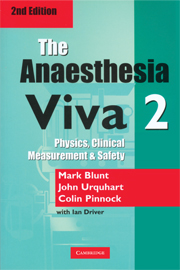Book contents
- Frontmatter
- Foreword to the First Edition
- Preface to the Second Editions
- Contents
- Physics, Clinical Measurement & Safety
- Clinical Anaesthesia
- Example 1
- Example 2
- 6 Example 3
- 7 Example 4
- Example 5
- Example 6
- Example 7
- Example 8
- Example 9
- Example 10
- Example 11
- Example 12
- Example 13
- Example 14
- Appendix 1
- Appendix 2
- Index
Example 12
Published online by Cambridge University Press: 05 February 2015
- Frontmatter
- Foreword to the First Edition
- Preface to the Second Editions
- Contents
- Physics, Clinical Measurement & Safety
- Clinical Anaesthesia
- Example 1
- Example 2
- 6 Example 3
- 7 Example 4
- Example 5
- Example 6
- Example 7
- Example 8
- Example 9
- Example 10
- Example 11
- Example 12
- Example 13
- Example 14
- Appendix 1
- Appendix 2
- Index
Summary
Scenario
A 77-year-old previously fit lady is admitted following a fall at home. She has sustained a fractured neck of femur and you are asked to anaesthetise her for hip screws. What information is important?
Consider head injury, reason for the fall – cardiac event? neurological event? Consider urgency of operation – probably able to wait for investigations and optimaisation. Past medical history? Usual pre anaesthetic checks – medication, allergies, previous surgery.
Request Hb, U and E, Glucose, CXR, ECG. Assuming these are normal the questioning will often turn to a choice of GA vs RA. There is little difference in long term mortality between them (over 3 months).
Contraindications to RA: Infection, neurological disease, anticoagulation, deformity of spine, patient refusal.
The examiner may lead you into choosing a spinal as the technique for this lady. You may be asked about spinal needle design and headache incidence and the anatomy of the layers through which you pass as you perform a spinal. Management of this case should include the avoidance of hypotension and consideration of sedation.
Make sure you can deal safely with a ‘total spinal’. This clinical scenario is often blended with a total spinal as the critical incident component of the viva in a seamless manner!
CRITICAL INCIDENT – ANAPHYLAXIS
You are giving a test dose of cefuroxime to an elderly man prior to inducing anaesthesia for his hip replacement.
- Type
- Chapter
- Information
- The Anaesthesia Viva , pp. 120 - 122Publisher: Cambridge University PressPrint publication year: 2003



